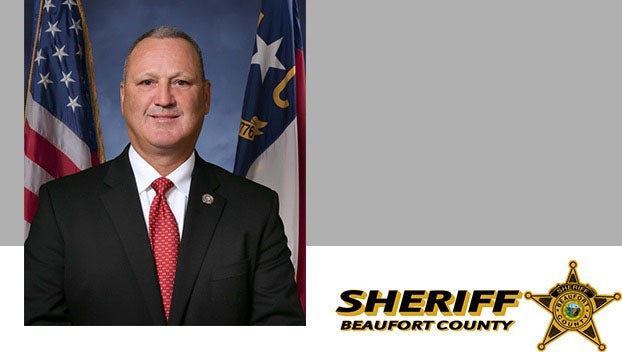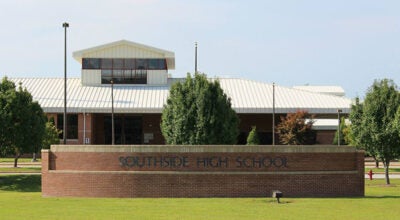FACES OF RECOVERY
Published 7:28 pm Saturday, April 14, 2012

Flora Nixon (above) stands outside her Aurora home, which must be demolished due to extensive damage from Hurricane Irene, (WDN Photo/Ashley Vansant)
AURORA — Sometimes, when she gets ready for bed at night, Helen Moore feels like the weight of the world is falling down on her.
Since Hurricane Irene came ashore in North Carolina last August, Moore, 73, has made her home in a trailer provided by the Federal Emergency Management Agency while she waits for volunteers to finish work on her home on Middle Street.
Before the hurricane made landfall, Moore left her home and rode out the storm at the home of a brother in Chocowinity.
When she returned, it was to utter devastation.
A tree had fallen across her yard, two gas tanks had floated off their foundations, trash and debris sat about one-foot thick in her yard and her home, which had never been flooded before, suffered from the effects of about three feet of water inside.
“I had no idea it was going to be like it was when I came home,” she said.
In the days afterwards, Moore salvaged what she could – including a beloved buffet that she had inherited from her mother — and stored those things in a storage shed she now has in her yard.
She has received some help from FEMA and insurance but it wasn’t nearly enough to cover the cost of repairs to the home where she raised her six children and cared for her husband through his final illness.
So Moore, who retired from her job at Hamilton Beach when the plant closed, is one of some 300 families who have applied for help from the North Carolina Conference United Methodist Disaster Recovery Committee.
Volunteer teams from as far away as Canada have come to Beaufort County to help Moore and others return to the lives they knew before last August.
They have gutted the downstairs of Moore’s home to the studs and have begun work repairing the floors, walls and windows that were damaged. But there’s a lot still to be done before Moore can move out of the temporary housing unit, as FEMA calls it, and into her home.
“Sometimes at bed time, I feel it,” she said. “But by next morning, I wake up and things look better.”
Moore said her mood brightens when the volunteers return to work or her daughter, Iris, takes her to pick out new flooring that will, eventually, be placed in her home.
“At least there’s a plan in place for me to get back in,” she said. “I feel like I’ll get back in here some day.”
While much of Beaufort County and eastern North Carolina recovered quickly from Hurricane Irene, others are still trying to get their lives back to normal — either on their own or with help of one of the non-profit groups that are in the area.
“These disasters do not just go away when the sun comes out. It’s not over then. It’s just beginning,” said Cliff Harvell, disaster response superintendent with the Methodist disaster response organization. “We figure we’ve got another two years of work to do.”
From its headquarters in a former automobile parts store in downtown Aurora, the organization has worked to gather construction materials, coordinate volunteer workers and help those affected by the storm recover from it.
But their effort has been hampered somewhat by the recent economic downturn, which has affected donations.
For example, Harvell said, after Hurricane Floyd, the N.C. Disaster Relief Fund operated by the governor’s office received almost $3 million in donations, but less than $75,000 after Hurricane Irene.
And the recent spate of disasters – from tornadoes in the South and Midwest to other floods and hurricanes in the nation in the last two years – have drawn volunteers to other parts of the country who might otherwise have come to eastern North Carolina to help, Harvell said.
“We have not had the volunteers here that we have in the past because of that,” he said. “All these disasters pull these people away.”
The location of much of the destruction has also affected recovery efforts.
Beaufort County alone had 3,600 registrations for help from FEMA following Hurricane Irene, as compared to 5,000 in the entire state of Vermont, Harvell said, but because many of those affected lived in largely rural areas of the county, the destruction wasn’t as widely noticed.
“This has been the most difficult situation we’ve ever had to work,” he said. “This is the hardest long-term recovery we’ve been involved in.
“Our operation will wrap up and there will still be people who need help because we have either run out of money or we have run out of volunteers,” Harvell said.
Compounding the problem, he said, is the push by FEMA to have all the trailers that are temporarily housing residents removed from areas considered to be flood zones by the start of hurricane season June 1.
Just a few miles away from where Moore lives, sisters Annie Kelly and Flora Nixon are also trying to recover from the storm.
Volunteers recently had been busy last week at Kelly’s home on Bay City Road installing new kitchen cabinets and new flooring. At the same time, they had been working to demolish Nixon’s home, which stands nearby, because it had been condemned.
The two rode out the storm in Nixon’s home, which was thought to be the more substantial structure and on higher ground.
As time passed after Hurricane Irene made landfall, Kelly, 65, looked out the window and “saw water rolling across my porch.” Eventually, they found themselves standing in water and “just praying ‘Lord, change the wind’,” she said.
Afterwards, when their floors were buckling “like a roller coaster,” their kitchen cabinets were coming apart and their furniture was disintegrating, they couldn’t believe their eyes.
“It’s all just a dream,” said Nixon. “I still can’t visualize the damage that it did. I see it and I still can’t believe it.”
Kelly said she doesn’t know when the work on her home will be finished.
“They don’t want to get my hopes up,” she said.
Meanwhile, the Methodist disaster response organization hopes to gather enough money, supplies and volunteers to build a new home for Nixon.
Volunteers are also working to help Ken Adams, 49, his wife and their four children return to their home just outside of Aurora on N.C. Highway 33.
Adams, a native of Aurora and owner of Wax’s Hand Car Wash, said the family talked about leaving the area after the hurricane but decided to try to repair their home and stay.
“This is a place that we love,” he said.
Like Kelly and Nixon, Adams and his family planned to stay in their home during the hurricane but by 10:30 on the morning the storm made landfall the family had “begun to bail water” out of the house and, by noon, the water was up to their ankles.
They were ultimately rescued by a neighbor and returned home about a week later.
“I broke down and cried like a baby,” Adams said. “It was just like losing a loved one.”
Since that time, much of the drywall in Adams’ home has been replaced, the damaged floors removed and much of the electrical work has been re-wired. But there’s still work left to do in the kitchen and bathroom, where plumbing needs to be repaired.
In the meantime, the family is living in a three-bedroom trailer that sits next to Adams’ home.
Even when the repairs are finished, Adams and the others – who lost most of their possessions during the flood – will continue to need help replacing everything from appliances to furniture and linens for their beds, Harvell said.
“Getting back into the house is just the start,” he said.
Donations can be made locally to the Irene disaster recovery at Local United Methodist Recovery P.O. 386, Aurora, NC 27806, counties can be specified. To volunteer your team for disaster recovery, call 1-888-440-9167.





